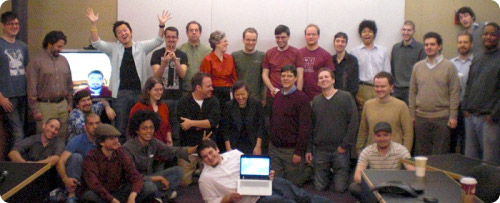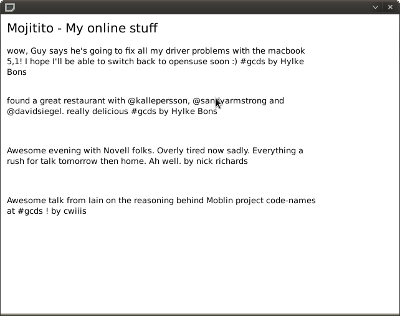
So, you’ve probably seen the news: litl webbook released! It’s the result of heavy work of an awesome team! Our website has a lot of information about the product from a user perspective, so I thought it would be nice to bring an overview of the more technical aspects of the litl OS that I find specially interesting. Scott has written some technical notes about our OS too.
Javascript
Almost all UI code is written in javascript using our GObject introspection-based binding called gjs (using SpiderMonkey engine). It was a quite interesting learning experience to write a large amount of UI code in javascript. By the time we started, I think no one in the team had any real experience with javascript. So, it took some time until we all agreed on the javascript programming idioms (the flexibility of the language may “cause” a lot of inconsistencies…) and on how to better/correctly take advantage of its features. Most of what we agreed in terms of coding style is in the gjs style guide. Doing stuff in javascript (i.e. not doing the whole UI in C or any other insanity like this) allowed us to prototype, refactor, rewrite things much faster. And that was crucial for us because the ideas around the UI design changed a lot during the first months of development and we ended up rewriting large chunks of code several times on the way. Doing relatively large scale stuff in javascript definitely requires very clear and strong guidelines in order to keep the code base sane – maybe a bit more than usual.
GNOME & FLOSS stuff
The OS is heavily based on well-known open source projects. Some facts: it’s based on Ubuntu (with great support by Canonical) and the UI is all written with GNOME platform and co. As I said, almost all code is written in javascript using gjs. Most of the UI is Clutter-based. We have our own specialized window and compositing manager that was implemented with our use cases in mind. We’re definitely one of the projects with the largest Clutter-dependent code base. We use GTK+ in just a few places where we needed more complex widgets (i.e. text entry). The web browser is Gecko-based and it’s pretty much implemented as a XUL app running in a separate process than the OS chrome. We use Evince and Totem (as browser plugins), GStreamer, Network Manager, and others. One interesting fact about our development process is that, in the ~2 years of heavy hacking, we had to adapt to major changes in the upstream projects we base our OS on. So, since we started, we had to port our UI to Clutter 0.6, then 0.8, and finally 1.0; had to port gjs to use the then-new GObject introspection scanner; migrated from Network Manager 0.6 to 0.7; and maybe some other major changes that I can’t remember now. We contributed to those projects as much as possible during the process.
No storage, just caching
You probably noticed that the device has “only” 2GB of storage. That won’t sound strange if you see this from a “webbook perspective”. One of the ideas behind the product concept is that the device serves as a much improved window to the web. In other words, the device provides a simple and beautiful way to access web content – among other things. So, we are pretty much only using storage for local caching. We don’t really store any real permanent data on the device. And that brings some interesting challenges on how we implemented the OS. So we had to implement some smart ways to cache as much content as possible and expire the right bits at the right time so that the general experience is nice and smooth. Simple example: the OS provides a way to access all your Flickr photos and videos (which can be a lot of photos and videos btw) but we never permanently store anything on disk. We cache things like rss feeds, profile pictures of your litl contacts, a lot of your Flickr photos and videos, website favicons, installed channels, etc. Each type of content may use a different way of expiring items and all that needs to fit in the relatively small storage space we have. You can guess how fun it was to hack on this. Hacking on syncing was even more fun though :-)
Syncing
Another interesting aspect of the device is that each device is connected to a litl account on our servers and all your stuff (browser cards, channels, settings, contacts, etc) is always synced in our servers. That means if you lose your device and get new one, you would just need to connect your device to same account and all your stuff would be nicely restored. Additionally, multiple devices can be associated to same account. In that case, they will automatically share channels and other things. If you add channel card in one, it will automatically appear on the other. We spent quite some time working on our syncing infrastructure (client and server), dealing some relatively complex problems – especially when dealing with making UI immediately react to sync-related changes in the local and remote datastores. The server side syncing stuff (and other server-side features) is implemented with Google App Engine, some bits in Amazon S3 and Django.
Seamless system updates
The OS comes with a smart update system. No package management involved. No user action needed to get system updates. In practice, we download and install a new OS image and fetch your data again from litl servers while the system is idle. The update system falls back to current image in case something goes wrong with new OS images. The update system allows us to keep updating, adding features, fixing bugs, and then push those updates to our users in a burden-free way.
We had a lot of fun hacking on the litl webbook. It’s always great to work in a team full of very smart people. Definitely learnt a lot in the process. We still have a lot of work to do of course but I already feel very proud of what we’ve accomplished so far. Exciting times!
Update: Saying that the UI is 99,99% Clutter-based is not very accurate. It’s a bit less than that :-)






